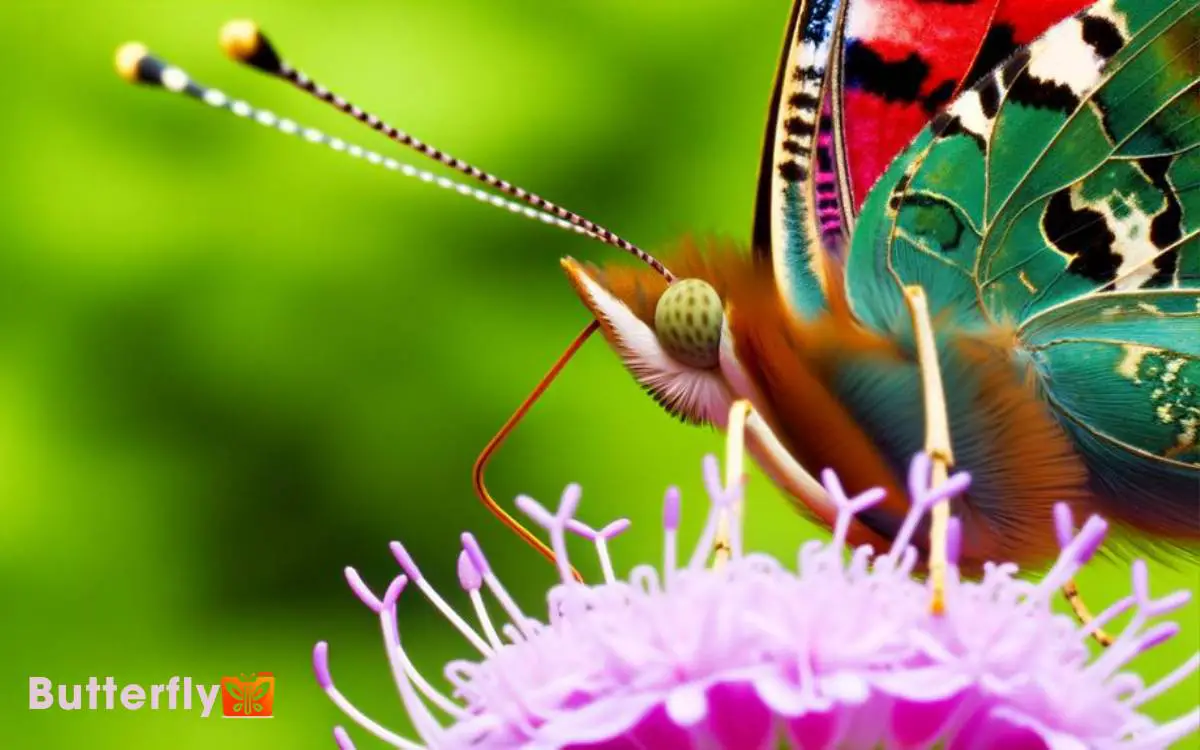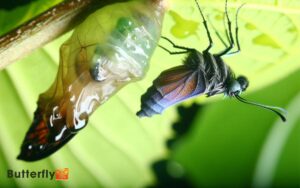Do Butterflies Have a Nose? Uncovering the Facts!
Butterflies don’t have a traditional nose; instead, they rely on specialized sensory organs on their antennae and legs to detect scents.
Chemoreceptors on their legs allow them to taste nectar, while their antennae are critical for locating mates by sensing pheromones.
These olfactory receptors on the antennae are fine-tuned to detect subtle chemical variations, aiding in survival by guiding them to food sources and mates.
Their unique sensory system is a fascinating adaptation that compensates for the lack of a conventional nose, allowing them to thrive in their environment. Explore further to uncover more intriguing details about butterfly sensory adaptations. Instead of using a conventional nose, butterflies rely on their antennae and specialized sensors on their feet to detect scents and locate food sources. Their ability to taste through their feet helps them identify suitable plants for laying eggs, ensuring the survival of their offspring. This unique adaptation is as remarkable as a dog with butterfly on nose, highlighting the fascinating ways nature equips different species to interact with their environment.

Key Takeaways
Butterfly Anatomy Overview
When examining butterfly anatomy, you’ll find that they possess a unique combination of structures adapted for survival and reproduction. Their bodies are divided into three main parts: the head, thorax, and abdomen.
On the head, you’ll notice compound eyes, which provide a broad field of vision, and antennae that are important for sensory perception.
The thorax houses powerful muscles that control the wings and legs, essential for flight and mobility. Each of their six legs ends in tiny claws, aiding in gripping surfaces.
The abdomen contains essential organs like the digestive and reproductive systems. Butterfly wings are covered in colorful scales, which not only create their vibrant patterns but also play a role in thermoregulation and camouflage.
Sense of Smell in Insects
Insects, including butterflies, rely on their antennae to detect chemical signals in their environment.
You’ll find that olfactory receptors located on these antennae are essential for identifying scents and pheromones, which play a key role in mating and navigation.
Unlike humans, insects don’t use a nose but have evolved specialized sensory structures to perform similar functions.
Antennae Function in Smell
Butterflies rely on their antennae, equipped with chemoreceptors, to detect and interpret various chemical signals in their environment.
These chemoreceptors are specialized sensory cells that respond to chemical stimuli, allowing butterflies to locate food, identify potential mates, and avoid predators.
Antennae function similarly to a nose in mammals, but with a higher sensitivity to pheromones and other environmental cues.
Here’s a simplified breakdown:
| Function | Description | Example |
|---|---|---|
| Food Detection | Identifies floral scents | Locating nectar sources |
| Mate Identification | Senses pheromones | Finding a suitable mate |
| Predator Avoidance | Detects alarming chemicals | Sensing danger nearby |
Understanding the role of antennae helps you appreciate how butterflies navigate and thrive in their habitats.
Olfactory Receptors in Insects
Olfactory receptors in insects are highly specialized sensory cells that detect a wide range of chemical compounds in their environment, enabling them to perform essential behaviors like finding food and mates.
These receptors are located on various parts of an insect’s body, primarily on their antennae. They function by binding to specific molecules, triggering nerve impulses that the insect’s brain interprets.
Unlike mammals, insects have a vast array of olfactory receptors, allowing them to distinguish subtle chemical variations.
Studies have shown that some insects can detect pheromones at concentrations as low as a few molecules per cubic centimeter. This heightened sensitivity is vital for survival, aiding in navigation, foraging, and avoiding predators.
Understanding these mechanisms offers insights into insect behavior and ecology.
Role of Pheromones
Pheromones play a crucial role in insect communication, acting as chemical signals that convey information about mating, territory, and danger.
- In butterflies, males often release pheromones to attract females, signaling their readiness to mate.
- You’ll find these chemical cues are detected by specialized olfactory receptors located on their antennae, providing precise and rapid information.
- Research shows that pheromones can also mark territories, ensuring that resources are efficiently used and reducing conflict.
- In danger situations, alarm pheromones alert others to predators, triggering evasive actions.
Understanding these intricate chemical communications underscores the sophistication of insect social structures and survival strategies.
Smelling Without a Nose
Although butterflies lack a traditional nose, they utilize specialized sensory organs on their antennae and legs to detect scents and pheromones in their environment.
These chemoreceptors are incredibly sensitive, allowing butterflies to identify chemical signals important for survival and reproduction.
When a butterfly lands on a flower, the chemoreceptors on its legs taste the nectar, providing information about the plant’s suitability. Similarly, the antennae play a significant role in locating mates by sensing pheromones released by potential partners.
Scientific studies show that these sensory adaptations enable butterflies to navigate their habitats effectively, find food sources, and engage in mating behaviors.
Understanding these mechanisms highlights the complexity and efficiency of butterfly sensory systems, despite their lack of a conventional nose.
Role of Antennae
Butterfly antennae serve as important sensory organs, equipped with specialized chemoreceptors that detect chemical cues essential for survival and reproduction.
You might not realize it, but these slender structures play a significant role in navigation, mate finding, and locating food sources. Antennae are finely tuned to perceive pheromones and other environmental signals that guide butterflies through their life cycles.
| Function | Description |
|---|---|
| Navigation | Sensing wind and direction |
| Mate Finding | Detecting pheromones |
| Food Location | Identifying floral scents |
| Environmental Cues | Monitoring temperature |
Understanding how antennae work can help you appreciate the complexity of butterfly behavior. These appendages are not just for show; they’re essential tools for interacting with the world.
Chemoreceptors Explained
Chemoreceptors, which are embedded within the butterfly’s antennae, play a vital role in detecting chemical signals from the environment.
These specialized sensory cells identify various chemical compounds, enabling butterflies to locate food sources and mates.
When molecules from flowers or pheromones in the air come into contact with these chemoreceptors, they trigger nerve impulses that the butterfly’s brain interprets, guiding its behavior.
You’ll find that chemoreceptors are highly sensitive and capable of differentiating between minute chemical variations. This specificity is important for survival, allowing butterflies to navigate their habitats effectively.
Understanding their function reveals how butterflies interact with their ecosystem. Essentially, while butterflies don’t have noses like mammals, their chemoreceptors perform a comparable function in sensing their surroundings.
Importance of the Proboscis
The proboscis, a long, coiled tube found in butterflies, plays a crucial role in feeding by allowing them to extract nectar from flowers efficiently. This specialized organ isn’t just for feeding; it’s a marvel of evolutionary adaptation.
When you observe a butterfly, you’ll notice the proboscis uncoiling to reach deep into flowers, demonstrating its critical function.
- Flexible structure: The proboscis can coil and uncoil, making it remarkably adaptable.
- Capillary action: This mechanism allows nectar to be drawn up through the tube effortlessly.
- Micro-trichomes: Tiny hair-like structures aid in the collection of nectar.
- Sensory abilities: The proboscis has chemoreceptors to detect specific substances.
- Hydration: It’s crucial for obtaining water and essential nutrients.
Understanding the proboscis underscores its importance beyond mere feeding.
Detecting Food Sources
Beyond its feeding capabilities, the proboscis also serves as a critical sensory organ that butterflies use to detect food sources.
You mightn’t realize it, but butterflies can taste with their feet. This allows them to identify suitable plants even before landing.
Their proboscis is equipped with chemoreceptors that detect sugars in nectar. These sensors are highly sensitive, enabling butterflies to find flowers rich in nectar from considerable distances.
Additionally, their antennae play a significant role. Antennae contain olfactory receptors that can detect volatile compounds released by flowers.
Through this combination of sensory tools, butterflies efficiently locate the best sources of nourishment, ensuring their survival and reproduction.
This intricate system highlights the evolutionary sophistication in their feeding behavior.
Finding Mates Through Scent
Butterflies rely on pheromones to locate and attract potential mates, using their antennae to detect these chemical signals with remarkable sensitivity.
These pheromones are essential for reproductive success. Males often release chemicals to entice females, who can sense these cues from significant distances.
To understand how butterflies use scent in mating, consider these points:
- Pheromone glands: Located on various body parts, including wings and abdomens.
- Antennae: Equipped with specialized sensilla for detecting pheromones.
- Behavioral responses: Males may exhibit courtship rituals upon detecting female pheromones.
- Species-specific signals: Each butterfly species has unique pheromones to prevent interspecies mating.
- Environmental factors: Temperature and wind affect pheromone dispersal.
Understanding these aspects reveals how integral scent is in butterfly mating behaviors.
Avoiding Predators
When considering how butterflies avoid predators, you should focus on their use of camouflage and mimicry, toxic chemical defenses, and flight evasion strategies.
They blend into their surroundings to remain unseen, or mimic more dangerous species to deter attackers.
Additionally, some butterflies store toxic compounds from their host plants, making them unpalatable, while others rely on erratic flight patterns to escape threats.
Camouflage and Mimicry
You might be surprised to learn that butterflies rely heavily on camouflage and mimicry to evade predators, blending seamlessly into their surroundings or imitating more dangerous species. These strategies are essential for survival in the wild.
Camouflage allows butterflies to merge with their environment, making it difficult for predators to spot them. Mimicry, on the other hand, involves resembling other species that predators tend to avoid.
Here are some fascinating examples:
- Leaf Mimicry: Some butterflies have wing patterns that look like leaves.
- Owl Eyes: Certain species have wing spots that mimic owl eyes, deterring predators.
- Bark Patterns: Some butterflies blend in with tree bark.
- Dead Leaf Appearance: Others mimic dead leaves to avoid detection.
- Mimicking Poisonous Species: Some butterflies imitate the appearance of toxic species.
These adaptations showcase the intricate ways butterflies survive in nature.
Toxicity as Defense
Many butterfly species deploy toxicity as an effective defense mechanism to deter predators. When you look at a Monarch butterfly, its bright coloration signals danger to potential predators.
Monarchs ingest toxins called cardenolides from milkweed plants during their larval stage, making them distasteful and sometimes harmful to predators. This toxicity guarantees that predators avoid them after a single, unpleasant encounter.
| Butterfly Species | Toxin Type |
|---|---|
| Monarch | Cardenolides |
| Pipevine Swallowtail | Aristolochic acids |
| Heliconius | Cyanogenic glycosides |
| Queen | Cardenolides |
| Common Crow | Alkaloids |
Utilizing toxins not only protects butterflies but also contributes to their survival and reproductive success. Understanding these mechanisms highlights the complex interactions between butterflies and their ecosystems.
Flight Evasion Strategies
In addition to chemical defenses, butterflies employ intricate flight evasion strategies to outmaneuver predators. They rely on erratic flight patterns and rapid directional changes, making it difficult for predators to catch them.
Butterflies exhibit sudden bursts of speed and sharp turns, confusing their pursuers. Some species even mimic leaves or other objects when gliding to appear less appetizing.
These unpredictable maneuvers collectively enhance their chances of survival.
- Erratic flight patterns: Sudden changes in speed and direction make tracking difficult.
- Rapid directional changes: Sharp turns and loops to evade grasping predators.
- Mimicry during flight: Imitating leaves or twigs to blend into surroundings.
- Startling displays: Flashing bright colors to disorient predators.
- Flying in groups: Safety in numbers, increasing survival chances.
Role of Plant Volatiles
Plant volatiles, a complex array of organic compounds, play an essential role in attracting butterflies by signaling the presence of nectar resources. These volatile organic compounds (VOCs) are emitted by flowers and can travel considerable distances.
Butterflies detect these volatiles using their antennae, which are equipped with specialized olfactory receptors. Different plant species emit unique blends of VOCs, allowing butterflies to distinguish between potential nectar sources.
Research demonstrates that certain volatiles, such as linalool and phenylacetaldehyde, are particularly effective at attracting butterflies.
| Compound | Source Plant | Effect on Butterflies |
|---|---|---|
| Linalool | Lavender, Basil | Strong attraction |
| Phenylacetaldehyde | Roses, Chocolate Cosmos | Moderate attraction |
| Benzaldehyde | Almonds, Cherry Blossoms | Mild attraction |
Understanding plant volatiles helps in conserving butterfly habitats and enhancing pollination strategies.
Comparison to Human Smell
You might be surprised to learn that butterflies don’t use a nose to detect scents; instead, their antennae serve as primary olfactory receptors.
Unlike humans, who’ve specialized olfactory cells in the nasal cavity, butterflies rely on chemoreceptors located on their antennae to sense plant volatiles.
This fundamental difference highlights the diverse evolutionary adaptations in sensory organs across species.
Sensory Organs in Butterflies
Butterflies don’t have a nose like humans, but they use their antennae and feet to detect scents and chemicals in their environment. Their sensory organs are highly specialized, allowing them to identify food sources, mates, and even predators.
You might find it fascinating how these delicate creatures interact with their surroundings:
- Antennae: Equipped with chemoreceptors, they detect pheromones and environmental scents.
- Feet: Gustatory receptors help them taste surfaces they land on, ensuring suitable locations for laying eggs.
- Proboscis: Functions in tasting nectar, contributing to their feeding process.
- Eyes: Compound eyes provide a wide field of vision, essential for detecting movement and orientation.
- Tarsi: Additional sensory organs on their legs enhance environmental interaction.
This sensory system enables butterflies to thrive despite lacking a nose.
Antennae as Smell Receptors
Unlike humans who use their noses to smell, butterflies rely on their antennae equipped with chemoreceptors to detect scents and pheromones in their environment.
These chemoreceptors are specialized sensory cells that can identify minute chemical particles in the air.
When a butterfly encounters a scent molecule, these receptors send signals to the butterfly’s brain, allowing it to interpret the information.
This detection system is highly important, enabling butterflies to locate nectar sources, identify potential mates, and avoid predators.
Human olfaction also involves chemoreceptors, but ours are located in the nasal cavity. While both systems serve similar purposes, butterfly antennae provide a broader range of detection, essential for their survival in diverse habitats.
Olfactory Differences in Species
Although both humans and butterflies rely on chemoreceptors for olfaction, the structural and functional differences in their sensory systems highlight the unique adaptations each species has evolved to thrive in their respective environments.
Humans have olfactory receptors located in the nasal cavity, while butterflies use their antennae, which are finely tuned to detect minute chemical signals in the air.
Here’s how their olfactory systems differ:
- Location of receptors: Human receptors are in the nasal cavity; butterfly receptors are on the antennae.
- Receptor density: Butterflies have a higher density of chemoreceptors.
- Specificity: Butterflies’ receptors are highly specific to pheromones and floral scents.
- Signal processing: Humans process olfactory signals in the olfactory bulb; butterflies use the antennal lobe.
- Behavioral responses: Butterflies use olfaction primarily for mating and foraging, while humans use it for more varied tasks.
Evolutionary Adaptations
Through millions of years of evolution, these delicate insects have developed specialized sensory adaptations that allow them to navigate their environments with remarkable precision.
Butterflies possess chemoreceptors on their antennae, legs, and proboscis, enabling them to detect chemical cues in their surroundings.
Their compound eyes, composed of thousands of ommatidia, provide a wide field of vision and sensitivity to various light wavelengths, aiding in locating flowers and mates. Additionally, their ability to sense polarized light helps them maintain direction during migration.
These adaptations have evolved to guarantee survival and reproductive success in diverse habitats. By fine-tuning their sensory organs, butterflies have become adept at finding food sources, avoiding predators, and selecting the best laying sites for their eggs.
Environmental Influences
How do environmental factors shape the behavior and physiology of butterflies? Environmental influences play a significant role.
Temperature, humidity, and light levels affect their development, migration patterns, and even reproductive cycles. You’ll notice butterflies adapting to seasonal changes in various ways.
- Temperature: Affects metabolic rates and development speed.
- Humidity: Influences the hydration levels necessary for survival.
- Light Levels: Dictate diurnal activity and can trigger migration.
- Plant Availability: Determines food sources and larval host plants.
- Predator Presence: Shapes defensive behaviors and coloration patterns.
Conclusion
You’ve discovered that butterflies don’t have noses like humans, but they excel at smelling with their antennae. Fascinatingly, each antenna can detect chemical cues from over a mile away!
These chemoreceptors help butterflies find mates and food by sensing plant volatiles.
So, next time you see a butterfly fluttering around, remember—it’s not just a pretty face; it’s a highly evolved sensory machine driven by intricate evolutionary adaptations and environmental influences.






